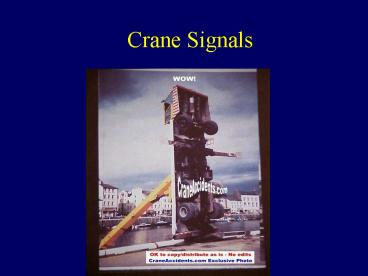Crane Signals - PowerPoint PPT Presentation
1 / 24
Title:
Crane Signals
Description:
In 2006, 314 accidents 107 deaths reported ... 'Where it is difficult for the crane operator to maintain clearance by visual ... Trolley Out/Extend the boom ... – PowerPoint PPT presentation
Number of Views:606
Avg rating:3.0/5.0
Title: Crane Signals
1
Crane Signals
2
Brief Crane Statistics
- 50 workers killed by cranes in US yearly
- In 2006, 314 accidents 107 deaths reported
- involving cranes
- 5 of accidents kill more than one person
Crane slipped off barge
3
Safety StatisticsFatal Accident Causes
- 39 power lines
- 12 assembly/dismantling
- 8 boom buckling
- 7 rigging failure
- 7 upset/overturn
4
Power Lines
- Signaling is especially important with over head
power lines - OSHA REGULATIONS
- Where it is difficult for the crane operator
to maintain clearance by visual means, a person
shall be designated to observe the clearance
between the energized power lines and the crane
and its load.
5
General Information on Signals
- When do you use signaling?
- A crane operator should always move loads
according to the established code of signals, and
use a signaler. - Use radio communications when crane operator can
not see signalman.
6
General Information on Signals
- Who can be a signaler?
- a person qualified to give crane signals to the
operator - there should be only one designated signaler at a
time - a crane operator must obey STOP signals no matter
who gives it.
7
General Information on Signals
- What should you do when in charge of signaling?
- be in clear view of the crane operator
- have a clear view of the
- load and the equipment
- keep persons outside the
- crane's operating area
- never direct a load
- over a person.
8
Examples of Signals
- Everything slow
- Palms together, slowly rubbing.
9
Examples of Signals
- Emergency Stop
- Arms Crossed Waving Back and Forth Horizontally.
10
Examples of Signals
- Routine Stop.
- Arm extended away from body, palm down.
11
Examples of Signals
- Raise the load / Cable up.
- Index finger points up, hand forearm make a
small circular motion.
12
Examples of Signals
- Raise the load slowly/Cable up, slowly
- One hand is held flat, palm down,
- over the other hand which
- has a pointed index
- finger making a circular
- motion under the palm area
13
Examples of Signals
- Swing the boom
- Outstretched arm with index finger pointing in
the desired direction.
14
Examples of Signals
- Raise the boom
- Outstretched arm, fingers clenched and thumb
pointing up
15
Examples of Signals
- Raise the boom - Hold the load
- Outstretched arm, thumb pointing up, hand opening
closing.
16
Examples of Signals
- Lower the load slowly/Cable down
- One hand is held flat, palm up,
- with the other hand
- having a downward pointed
- index finger making a
- circular motion over the
- palm area
17
Examples of Signals
- Lower the boom
- Outstretched arm, fingers clenched with thumb
pointing down.
18
Examples of Signals
- Lower the boom-Hold the load
- Outstretched arm, fingers clenched with thumb
pointing down. hand opening closing.
19
Examples of Signals
- Raise the boom - Hold the load
- Outstretched arm, thumb pointing up, hand opening
closing.
20
Examples of Signals
- Trolley Out/Extend the boom
- Both arms outstretched, fingers clenched with
both thumbs pointing outward
21
Examples of Signals
- Retract the boom
- Both arms outstretched, fingers clenched with
both thumbs pointing inward.
22
Examples of Signals
- Walk the crane forward
- Forearms circling forward, away from the body.
- Reverse the motion to walk the crane backward.
23
OSHA EXAMPLE
- Employees 1 and 2 were being elevated
approximately 220 feet in a personnel platform
secured to the jib of a grove tm-9120 hydraulic
crane. The employees were getting into position
to sandblast the ceiling of the kingdome. Radio
communication was used to transmit crane signals
from the platform to the crane operator. When the
platform was extended into the ceiling area,
undue stress was placed on the jib and it failed.
Employees 1 and 2 were thrown out and fatally
injured when they fell to the ground. Lack of
adequate communication and fall protection
contributed to the accident.
24
Sources
- http//www.craneaccidents.com/stats.htm
- http//www.cdc.gov/niosh/crane.html
- http//www.womanoperator.com/crane20signals.htm
- http//www.ccohs.ca/oshanswers/safety_haz/material
s_handling/signals.html































